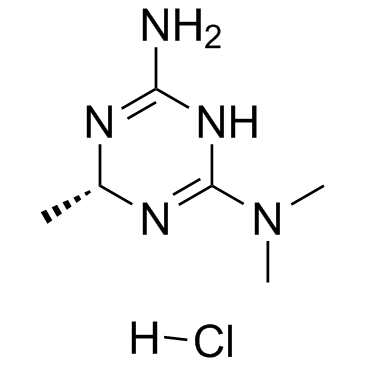Imeglimin hydrochloride
Modify Date: 2024-01-12 07:17:00

Imeglimin hydrochloride structure
|
Common Name | Imeglimin hydrochloride | ||
|---|---|---|---|---|
| CAS Number | 775351-61-6 | Molecular Weight | 191.66 | |
| Density | N/A | Boiling Point | N/A | |
| Molecular Formula | C6H14ClN5 | Melting Point | N/A | |
| MSDS | N/A | Flash Point | N/A | |
Use of Imeglimin hydrochlorideImeglimin hydrochloride is the first antidiabetic compound that induces an increase in mitochondrial phospholipid composition, contributing to improvements in hepatic mitochondrial function. |
| Name | Imeglimin hydrochloride |
|---|---|
| Synonym | More Synonyms |
| Description | Imeglimin hydrochloride is the first antidiabetic compound that induces an increase in mitochondrial phospholipid composition, contributing to improvements in hepatic mitochondrial function. |
|---|---|
| Related Catalog | |
| Target |
Mitochondrial phospholipid[1] |
| In Vitro | Imeglimin also reduces reactive oxygen species production and increases mitochondrial DNA. Imeglimin effects on mitochondrial phospholipid composition can participate in the benefit of Imeglimin on mitochondrial function. Imeglimin increases mtDNA content without modifying PGC1α expression. Imeglimin amplifies the effects of high-fat, high-sucrose diet (HFHSD) on both cardiolipin and phosphatidylserine (PS) content, whereas it tends to restore phosphatidylcholine (PC), phosphatidylethanolamine (PE), and phosphatidylinositol (PI) content to normal values in HFHSD mitochondria[1]. |
| In Vivo | Imeglimin is administered orally at 200 mg/kg b.i.d. during the last 6 weeks of the HFHSD feeding protocol. A slight decrease in body weight and food intake associated with some diarrhea is observed but only during the first few days of treatment. Imeglimin significantly decreases hyperglycemia, restores normal glucose tolerance, and improves insulin sensitivity[1]. |
| Kinase Assay | Rotenone-sensitive NADH-ubiquinone oxidoreductase (complex I, CI) is assayed using 100 μM Decylubiquinone as an electron acceptor and 200 μM NADH as a donor in a 10 mM KH2PO4/K2HPO4 buffer, pH 7.5, containing 3.75 mg/mL BSA, 2 mM KCN, and 7.5 μM Antimycin A. NADH oxidation is measured at 340 nm before and after the addition of 4 μM Rotenone to allow the calculation of the Rotenone-sensitive-specific activity, which is characteristic of CI. Succinate-ubiquinone reductase (complex II, CII) activity is quantified by measuring the decrease in absorbance resulting from the reduction of 100 μM dichlorophenolindophenol at 600 nm. The measurement is performed in 50 mM KH2PO4/K2HPO4 buffer, pH 7.5, in the presence of 30 mM Succinate, 100 μM Decylubiquinone, 2 μM Rotenone, and 2 mM KCN. Coenzyme Q-cytochrome c-oxidoreductase activity (complex III, CIII), is quantified by measuring the increase in absorbance resulting from the reduction of 100 μM cytochrome c at 550 nm. The measurement is performed in 50 mM KH2PO4/K2HPO4 buffer, pH 7.5, in the presence of 100 μM Decylubiquinone previously reduced by dithionite, 50 μM EDTA, and 1 mM KCN. The specific activity is calculated by subtracting the activity obtained before and after addition of 5 μg/mL Antimycin A. 3-Hydroxyacyl-CoA dehydrogenase (HAD) activity is quantified by measuring the decrease in absorbance at 340 nm resulting from the oxidation of NADH (200 μM) and the reduction of S-acetoacetyl-CoA (50 μM). The measurement is performed in Imidazole (40 mM) and EDTA (60 μM), pH 7[1]. |
| Animal Admin | Mice[1] Male C57BL/6JOlaHsd mice at 4 weeks old are housed at 22°C with a 12-h light/dark cycle. After 1 week of acclimatization, 5-6-week-old mice are divided into two groups: one with free access to a standard chow diet (SD) and the other with free access to a pelleted HFHSD diet for 16 weeks. Animals receive Imeglimin 200 mg/kg b.i.d. by oral gavage during the last 6 weeks of HFHSD feeding. Control SD and HFHSD mice are treated by oral gavage with methylcellulose 0.5% as a vehicle for drug treatment (5 mL/kg). Food intake is measured every day during the first week and twice a week until the end of the experiment. Results are expressed as grams per day per mouse. |
| References |
| Molecular Formula | C6H14ClN5 |
|---|---|
| Molecular Weight | 191.66 |
| Storage condition | 2-8℃ |
| Imeglimin (hydrochloride) |